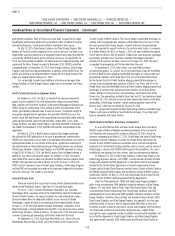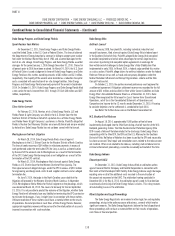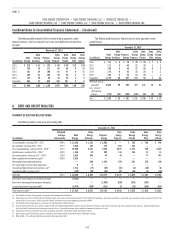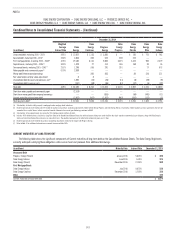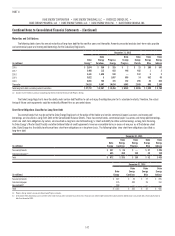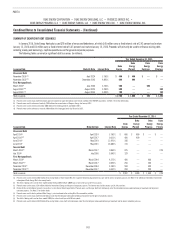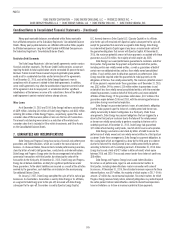Duke Energy 2015 Annual Report Download - page 157
Download and view the complete annual report
Please find page 157 of the 2015 Duke Energy annual report below. You can navigate through the pages in the report by either clicking on the pages listed below, or by using the keyword search tool below to find specific information within the annual report.
137
PART II
DUKE ENERGY CORPORATION • DUKE ENERGY CAROLINAS, LLC • PROGRESS ENERGY, INC. •
DUKE ENERGY PROGRESS, LLC • DUKE ENERGY FLORIDA, LLC • DUKE ENERGY OHIO, INC. • DUKE ENERGY INDIANA, INC.
Combined Notes to Consolidated Financial Statements – (Continued)
security to meet their obligations under the Plea Agreements. Payments under
the Plea Agreements will be borne by shareholders and are not tax deductible.
Duke Energy Corporation has agreed to issue a guarantee of all payments
and performance due from DEBS, Duke Energy Carolinas and Duke Energy
Progress, including but not limited to payments for fines, restitution, community
service, mitigation and the funding of, and obligations under, the environmental
compliance plans. As a result of the Plea Agreements, Duke Energy Carolinas
and Duke Energy Progress recognized charges of $72 million and $30 million,
respectively, in Operation, maintenance and other on the Consolidated
Statements of Operations and Comprehensive Income during 2014. Payment of
the amounts relating to fines and restitution were made between May and July
2015. The Plea Agreements do not cover pending civil claims related to the Dan
River coal ash release and operations at other North Carolina coal plants.
On May 14, 2015, Duke Energy reached an Interim Administrative
Agreement with the U.S. Environmental Protection Agency Office of Suspension
and Debarment that avoids debarment of DEBS, Duke Energy Carolinas or Duke
Energy Progress with respect to all active generating facilities. The Interim
Administrative Agreement imposes a number of requirements relating to
environmental and ethical compliance, subject to the oversight of an independent
monitor.
Potential Groundwater Contamination Claims
Beginning in May 2015, a number of residents living in the vicinity of the
North Carolina facilities with ash basins received letters from NCDEQ advising
them not to drink water from the private wells on their land tested by NCDEQ
as the samples were found to have certain substances at levels higher than the
criteria set by the North Carolina Department of Health and Human Services
(DHHS). The criteria, in some cases, are considerably more stringent than federal
drinking water standards established to protect human health and welfare.
The Coal Ash Act requires additional groundwater monitoring and assessments
for each of the 14 coal-fired plants in North Carolina, including sampling of
private water supply wells. The data gathered through these Comprehensive
Site Assessments (CSAs) will be used by NCDEQ to determine whether the
water quality of these private water supply wells has been adversely impacted
by the ash basins. Duke Energy has submitted CSAs documenting the results of
extensive groundwater monitoring around coal ash basins at all 14 of the plants
with coal ash basins. Generally, the data gathered through the installation of
new monitoring wells and soil and water samples across the state have been
consistent with historical data provided to state regulators over many years.
The DHHS and NCDEQ sent follow-up letters on October 15, 2015, to residents
near coal ash basins who have had their wells tested, stating that private well
samplings at a considerable distance from coal ash impoundments, as well
as some municipal water supplies, contain similar levels of vanadium and
hexavalent chromium which leads investigators to believe these constituents
are naturally occurring. It is not possible to estimate the maximum exposure of
loss, if any, that may occur in connection with claims which might be made by
these residents.
Duke Energy Carolinas
New Source Review
In 1999-2000, the U.S. Department of Justice (DOJ) on behalf of the EPA
filed a number of complaints and notices of violation against multiple utilities,
including Duke Energy Carolinas, for alleged violations of the New Source Review
(NSR) provisions of the Clean Air Act (CAA). The government alleges the utilities
violated the CAA when undertaking certain maintenance and repair projects at
certain coal plants without (i) obtaining NSR permits and (ii) installing the best
available emission controls for sulfur dioxide, nitrogen oxide and particulate
matter. The complaints sought the installation of pollution control technology on
generating units that allegedly violated the CAA, and unspecified civil penalties in
amounts of up to $37,500 per day for each violation.
In 2000, the government sued Duke Energy Carolinas in the U.S. District
Court in Greensboro, North Carolina, claiming NSR violations for 29 projects
performed at 25 of Duke Energy Carolinas’ coal-fired units. Duke Energy
Carolinas asserted there were no CAA violations because the applicable
regulations do not require NSR permitting in cases where the projects undertaken
are routine or otherwise do not result in an increase in emissions. In 2011, the
parties filed a stipulation agreeing to dismiss with prejudice all but 13 claims at
13 generating units, 11 of which have since been retired. On October 20, 2015,
the Court approved and entered a consent decree to resolve this matter. Under
the consent decree, Duke Energy Carolinas will retire by the end of 2024, the
remaining units at the Allen plant that are part of the litigation as well as a
third unit that is not part of the litigation. Prior to closure, Duke Energy Carolinas
will comply with new, lower emissions limits at the Allen units named in the
litigation. Additionally, Duke Energy Carolinas will spend approximately $4 million
on environmental projects and donations and pay a civil penalty of $975,000.
This matter is now closed.
Asbestos-related Injuries and Damages Claims
Duke Energy Carolinas has experienced numerous claims for
indemnification and medical cost reimbursement related to asbestos exposure.
These claims relate to damages for bodily injuries alleged to have arisen from
exposure to or use of asbestos in connection with construction and maintenance
activities conducted on its electric generation plants prior to 1985. As of
December 31, 2015, there were 156 asserted claims for non-malignant cases
with the cumulative relief sought of up to $37 million, and 70 asserted claims for
malignant cases with the cumulative relief sought of up to $11 million. Based on
Duke Energy Carolinas’ experience, it is expected that the ultimate resolution of
most of these claims likely will be less than the amount claimed.
Duke Energy Carolinas has recognized asbestos-related reserves of $536
million and $575 million at December 31, 2015 and 2014, respectively. These
reserves are classified in Other within Deferred Credits and Other Liabilities
and Other within Current Liabilities on the Consolidated Balance Sheets. These
reserves are based upon the minimum amount of the range of loss for current
and future asbestos claims through 2033, are recorded on an undiscounted basis
and incorporate anticipated inflation. In light of the uncertainties inherent in a
longer-term forecast, management does not believe they can reasonably estimate
the indemnity and medical costs that might be incurred after 2033 related to
such potential claims. It is possible Duke Energy Carolinas may incur asbestos
liabilities in excess of the recorded reserves.
Duke Energy Carolinas has third-party insurance to cover certain losses
related to asbestos-related injuries and damages above an aggregate self-
insured retention. Duke Energy Carolinas’ cumulative payments began to exceed
the self-insurance retention in 2008. Future payments up to the policy limit will
be reimbursed by the third-party insurance carrier. The insurance policy limit
for potential future insurance recoveries indemnification and medical cost claim
payments is $847 million in excess of the self-insured retention. Receivables for
insurance recoveries were $599 million and $616 million at December 31, 2015
and 2014, respectively. These amounts are classified in Other within Investments
and Other Assets and Receivables on the Consolidated Balance Sheets. Duke
Energy Carolinas is not aware of any uncertainties regarding the legal sufficiency
of insurance claims. Duke Energy Carolinas believes the insurance recovery
asset is probable of recovery as the insurance carrier continues to have a strong
financial strength rating.











